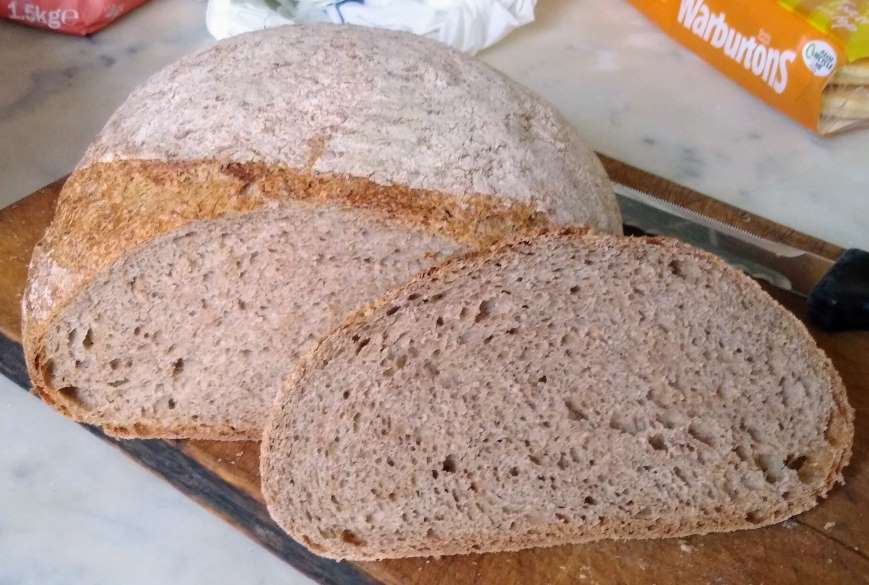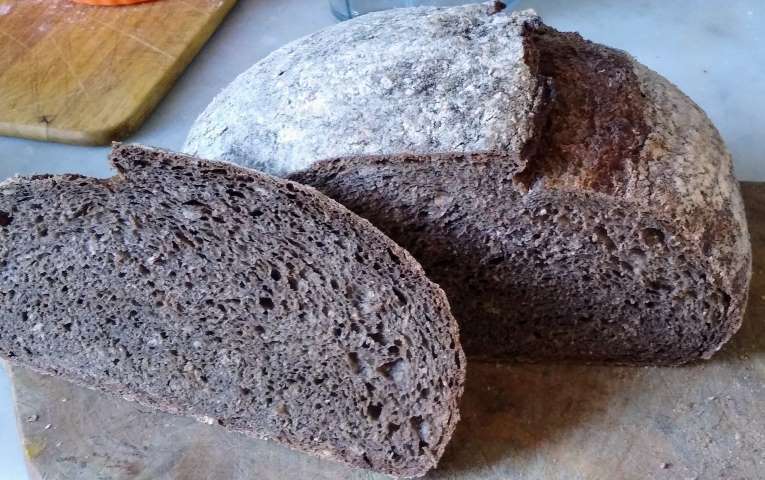Following on from some posts on the Big(a) controversy thread, here are a couple more recent wholegrain wheat loaves I baked with a 50% 'shaggy' SD biga.
The first was a very simple control bake with nothing else apart from 100% UK wholemeal wheat bread flour.

50% (200g) of the flour was used in the biga which was made with 90g water and 10g 100% hydration SD starter. The biga was left to ferment at room temperature for 24h and then mixed in with the remaining 200g of flour and 4g salt, with extra water added to bring the final dough mix to 75% hydration.
The bulk ferment was, again, very accelerated compared to when I used to use a liquid SD levain, and for this reason, the BF again run away from me a little and I didn't have enough time to do the number of S&Fs and laminations I was intending to do.
For 100% wholegrain wheat, it was a very nice loaf, OK crumb and reasonably moist, but a little on the crumbly side after a day or so from the bake.
Main points for improvement in my mind were to develop the gluten more with more laminations and to shape and bake earlier.
The second, I decided to increase hydration to around 80-85% and add some mashed potato for more softness and moisture.

I also had some carob flour (its more like cocoa powder actually) which I though might go well with the wholegrain wheat taste and make the bread nice and dark too, so added about 10g into the final dough flour. The biga was made in exactly the same way as the first loaf. The final dough had 170g wholegrain wheat bread flour, 10g carob flour, and 100g potato (assumed to provide 80g of water to the loaf), so water added to bring the final hydration to 80%. When mixing, the final dough was very dry so added some more water, taking it to around 85% hydration in the end.
The final loaf was soft and moist, with very nice taste, but again, due to external factors, was not able to do as many S&Fs and laminations as I would have like to.
Final reflections on the second loaf are that the texture is very nice and more smooth and less crumbly than the 1st loaf, the taste of the carob is actually very nice, and there is more sourness than in the 1st bake. I think the carob taste would be complemented well by some sunflower seeds, so will be trying to add some of those to the next such loaf I make.
- ReneR's Blog
- Log in or register to post comments
Those look terrific! Even with the heavy ingredients, they have such good height and open pores. I did try making a stiff biga after reading your earlier posts about it, except it was a sourdough levain instead of a biga. The biggest problem for me was that I mix by hand and it was very difficult to get the stiff levain to accept the water so it could mix with the other ingredients. Otherwise the dough acted pretty much as usual for me. I don't remember, but I may not have used as high a percentage of levain as you write about.
More experiments are in order!
TomP
I find that using what I call the 'shaggy' biga, (see photo), the strands mix in quite easily. I also only mix by hand, so simply put in a large bowl the remaining flour + salt, add the water I have calculated for the final hydration, plop the biga strands into crater with the water in the middle of the flour and simply mix till it all comes together with a dough whisk, or even just a spoon or plastic dough scraper, and it all comes together really easily.
The so-called 'shaggy' biga is the key here. It is an almost zero gluten fermentation so easy to mix-in to the final dough. It also seems to me to preserve the gluten from the LAB so it is available for the bulk fermentation when it is needed.
Mixing the water and flour for the biga should produce almost no gluten structure whatsoever.
Yes, that's what I did. I don't agree with you about no gluten development, though. Each of those blobs is wet inside, and wet flour develops gluten on its own. Each blob also ferments inside. When I went to mix in the recipe's water, I had a heck of a time getting it all to merge together. All the blobs were very gluey. True, it was easier than if I had all the levain as a single stiff mass. But I still didn't like doing the mixing.
As I said, more experimenting!
Yes, I get what you are saying and you are right about not being zero gluten. But found that it didn't matter too much, in the first instance, if the blobs were not very smoothly incorporated into the final mix. I kneaded it a bit after the mix and got it all into a descent if not super smooth consistency, and then it got smoother after each S&F.
That's a good point. As long as they are not dry, blobs will tend to blend in over time.
You have been making bigas, and I started with sourdough, so that's a difference too.
I'm looking forward to trying this with my home milled flour. I'll use 20g of potato flakes + 80g of water instead of potato.
I remember ming telling me about using a biga like this in the midst of a discussion of flourless sourdough starters.
Do you think 50% is the sweet spot for the biga?
Hmm, good question! I had done loaves with less biga using CY, and was not very impressed.
The 50% came about as part of the experimentation. If you remember, I first started with a mix of white spelt SD biga and dark rye liquid levain. Once that worked, I got more confident about the biga part, so decided, more for experimental protocol purposes, to try a 50% white spelt SD biga because previous 50% white spelt loaves with liquid levain, were OK/edible, but rather on the limit, so it seemed to me that if I wanted to prove to myself whether biga somehow helped provide a better structure to weak or unbalanced gluten flours, 50% white spelt would be a good benchmark, hence the 50%.
In the end the 50% worked well, so I have kept it. I guess I am also nervous that more than that might be too much, but might be good to try and see.
My hunch is that one needs some fresh gluten forming capacity from the additional flour as well as the low gluten formation ferment from biga to have a good structure. I have a gut feeling that even with the low gluten deterioration of the 'shaggy' biga, going too high with the pre-ferment (biga) might lead to less prime quality gluten than would be possible with the fresh final mix flour.
But a good point to experiment more around.
I'm, also trying to pluck up the courage to try a 100% white spelt loaf using this type of biga. Past attempts only worked with pretty low hydration and still went into the oven pretty flat looking, even if they were lifted by the oven spring. The gliadin in spelt makes it very tricky to work with and it can also run away with the fermentation very very quickly too.
Yes, I have come across the video ming refers to and the biga technique I use sounds the same as the one ming uses. It seems that this type of biga is widely used in Italy, but not necessarily based on a SD starter. Being able to find out more about it locally in Italy and to fill in the gaps of what was available online helped me understand the thinking behind it better and make the breakthrough I feel I have made with my SD experiment.
Interesting that ming seems to do a 100% biga, just adding the missing water for the final dough.